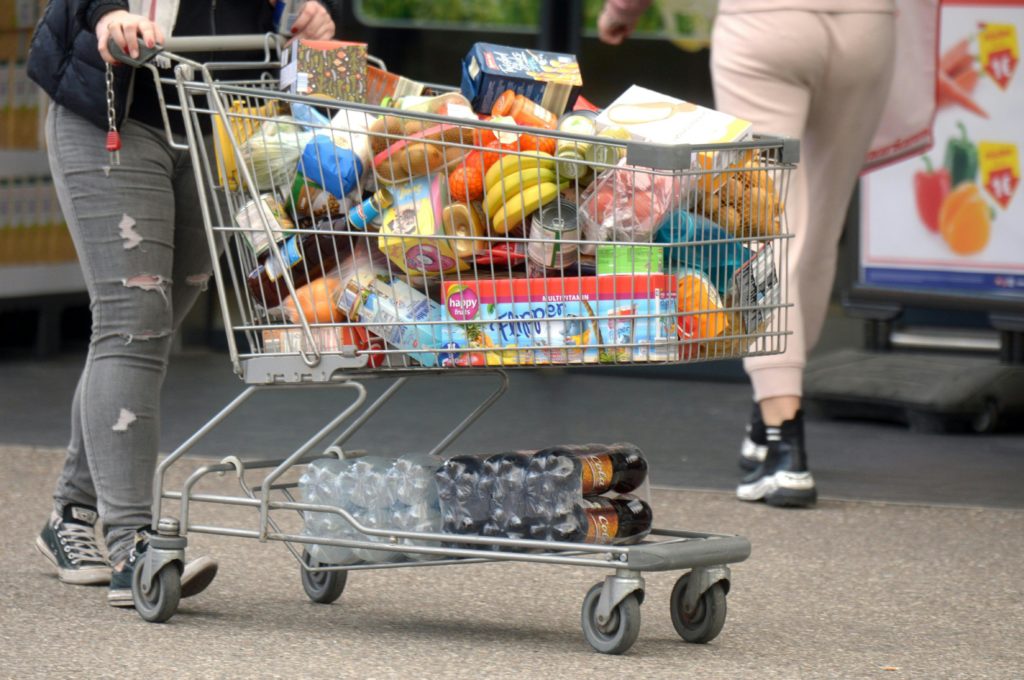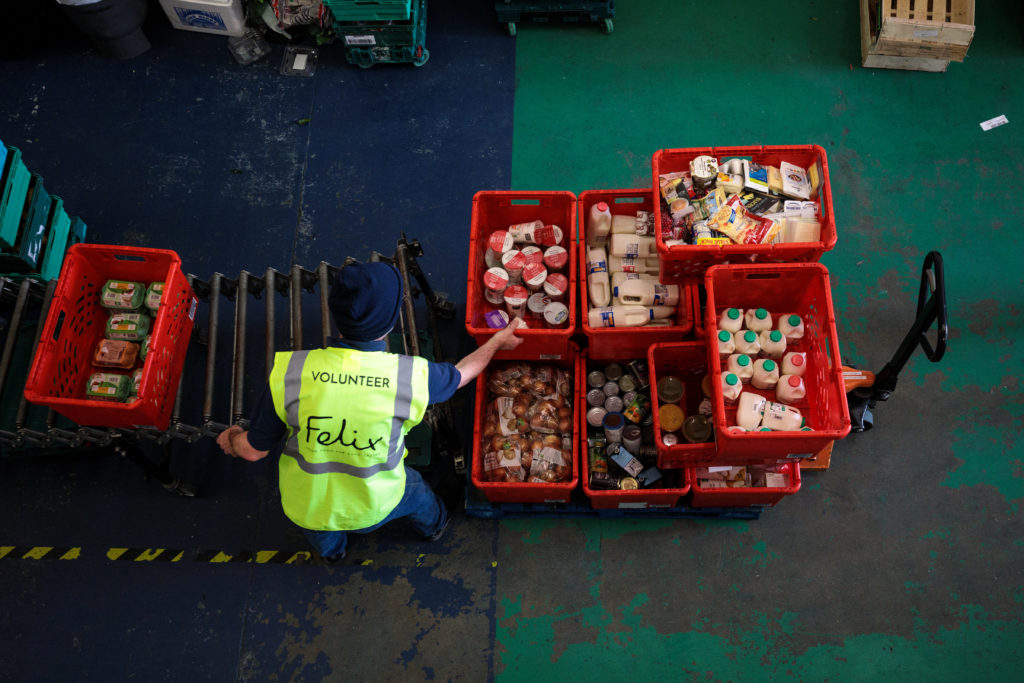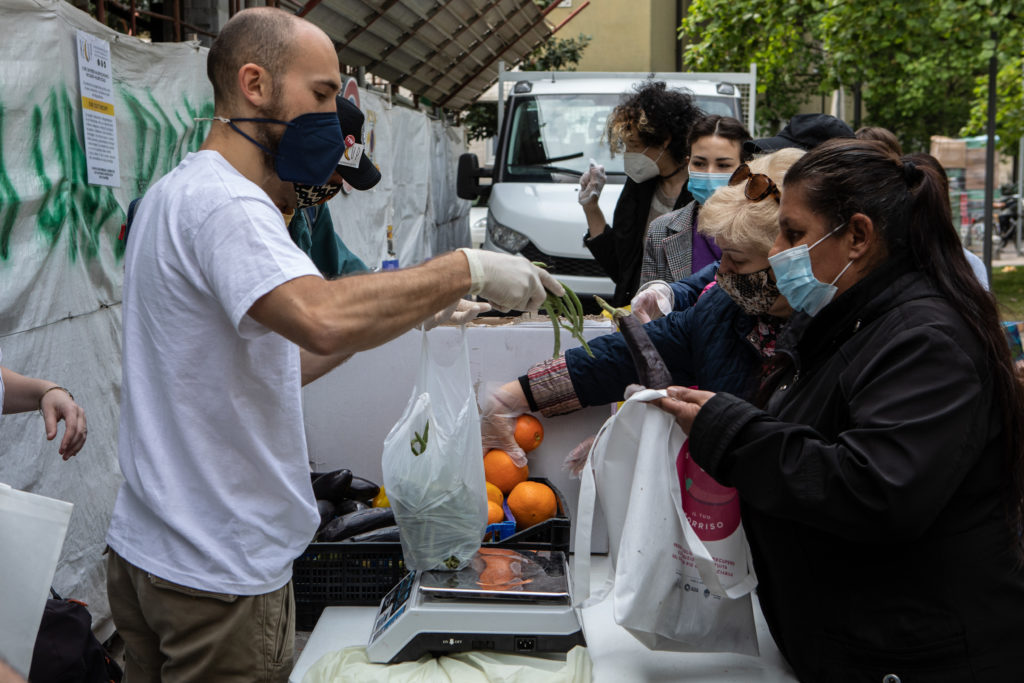Abundance and variety are expected in grocery stores and markets in many of the world’s middle- and high-income countries. Consumers peruse fully stocked stores selling both in-season and out-of-season food in attractive displays and purchase goods to last them until their next shopping trip.
Not all of that food, however, is going to be consumed. On average, one-third of purchases from that grocery trip will be wasted.
“I think every time somebody throws some food away . . . there’s a little bit of guilt saying ‘geez, I shouldn’t have done that’,” said John Mandyck, CEO of Urban Green Council. “I don’t think they understand the scale and the consequences.”
People may think that some of their food spoiling is not a big deal, but the occasional carton of milk or container of strawberries going to waste is actually part of a global problem.
Food waste is rampant across the world’s middle- and high-income countries. Approximately 1.3 billion tons of food is lost or wasted per year.
“A significant amount of food is produced not just in the United States, but around the world that is not ultimately consumed,” said Caitlin Welsh, director of the Global Food Security Program at CSIS. “We are experiencing record levels of food insecurity for a number of reasons having to do with climate change, Covid-19, conflict, and now the impact of Russia’s war in Ukraine.”
- Food Loss
-
Food that gets spilled, spoilt or otherwise lost, or incurs reduction of quality and value during its process in the food supply chain before it reaches its final product stage.
- Food Waste
-
Food that completes the food supply chain up to a final product, of good quality and fit for consumption, but still doesn’t get consumed because it is discarded, whether or not after it is left to spoil or expire.
Source: UNEP
Forty percent of all food wasted in industrialized countries happens at the grocery and market retail level, according to the Food and Agriculture Organization of the United Nations. Decreasing the amount of food wasted could help to eliminate food insecurity, ultimately resulting in access to consistent food sources for more people internationally.
These consumer shopping and cooking habits must be addressed when tackling the global food waste problem.
Food waste prevention at the consumer level starts with a person’s shopping habits in grocery stores. And if one-third of each grocery trip goes to waste on average, then that means one-third of shopping budgets are also being wasted.
The American Journal of Agricultural Economics found that the total annual cost of household food waste in the United States is $240 billion per year, or about $1,866 per individual household.
In the United States, household food waste is estimated at 59 kilograms per household per year. Worldwide, the numbers range.
This is a significant financial hardship on households, especially in a time of rapidly rising food prices. But food waste also has consequences on a global scale, including environmental harms in today’s already struggling climate.
Waste Beyond Food
As uneaten food makes its way from production to landfill, it has serious climate impacts at every stage of its journey.
Some of the foods producing the highest amount of greenhouse gasses are on par with other activities notorious for producing greenhouse gases, including automobiles and electricity.
Mandyck took a container of strawberries as an example, saying that the fuel used to plant and harvest the field, provide electricity for irrigation systems, and transport produce from farm to packaging to storage all generate emissions that are harmful to the environment. A shopper’s car, used to drive to the grocery store, also generates many of these same harmful emissions
“It’s this fully laden point of carbon that’s put into this one product because it goes through so many distribution channels before it gets to the consumer,” he said. “That’s why the carbon footprint of food is just so large.”
Consumers can help reduce emissions by reducing how much they purchase and how much they throw away, and ultimately eating more of what they buy.
Consumer Behaviors Contributing to Food Waste
Why do consumers continue to waste food when it costs American households almost $2,000 a year on average?

Consumer habits such as purchasing more food than needed, the fear of consuming food past the “best by” or expiration label, and the tendency to avoid purchasing imperfect foods contribute to the majority of food waste in most developed countries.
According to Welsh, the nature of American grocery stores does not encourage consumers to consider the impacts of food waste.
Grocery stores in America are consistently stocked with an abundance of produce at all times of the year, regardless of whether these items are out-of-season or primarily purchased during certain seasons, Welsh said.
“The grocery store culture of having an abundance of food available all times, all hours of every day . . . ultimately contributes to food waste because it’s not at all points of every day around the year that certain foods are consumed,” Welsh said.
For most products available in grocery stores in the United States, there are multiple variations of each item made by different suppliers, ensuring the shelves are always stocked. The abundance of food available in grocery stores at any time of the day is great for consumers but increases food waste.
Consumers in the United States also tend to consistently indulge in unplanned purchases that cause them to overbuy produce, which spoils naturally after a couple days, said Mandyck.
The American Marketing Association’s Journal of Public Policy and Marketing argues that American materialism and identity signaling largely contribute to the over-acquisition of food. When a consumer has the means to waste food, it is often viewed as a signal of wealth and power.
“We’re simply buying too much food and throwing it away,” said Mandyck. “Nobody does it on purpose . . . [but] we need to start changing our behavior . . . because food is the number one item in our landfills.”
The Issue With Date Labels
Confusion about whether food is unsafe to consume or simply past its peak freshness, brought on by an inconsistent labeling system, leads both stores and consumers to throw out a great deal of edible food.
According to a survey conducted by the John Hopkins Bloomberg School of Public Health, most packaged food items in the United States contain date labels. However, while other countries have federal legislation standardizing their date labels, the United States does not, except for infant formula.
That survey found 37 percent of consumers always throw away food when it is near the date on the package, whereas 84 percent do so occasionally. Over a third of the participants thought date labeling was federally regulated, and 26 percent reported they were unsure.
The broad range of labels, including “best before,” “sell by,” “use by,” “freshest by” or labels indicating an expiration date, cause confusion for consumers who are not educated on what these labels mean.
“They just think it’s a deadline,” Mandyck said. “It says it’s a food hazard or food safety deadline, and so they’re artificially throwing things away just because they’re scared.”
The survey found that consumers tend to misinterpret these labels as expiration dates, which leads to the majority of household food waste each year. However, these labels are meant to indicate how long the item is at its peak freshness, and its quality only gradually decreases after the marked date.
“Many people across the country think that as soon as a product nears its expiration date, it becomes unsafe to consume and therefore they will throw that food away,” Welsh said. “That’s absolutely not the case. Food remains safe to consume and remains nutritious up until and beyond [many of the dates] that you might see on the packaging. But households simply don’t know that.”
There have been efforts by the U.S. government to mitigate confusion about date labels. The Food Recovery Act, last updated in 2017, included a proposition to standardize date labeling nationally using the same language as the voluntary industry standard and states that food past the quality date must be sold or donated. This act proposes using two labels to avoid confusion for the consumer: “best if used by” and “use by.”
Although federal legislation to standardize date labels has been proposed, it has been unsuccessful in passing through Congress, leaving regulation up to the states. This has resulted in inconsistent industry standards across state and local lines that lead to confusion for consumers.
Learning to Love Ugly Produce
Although consumers are primarily responsible for contributing to a majority of food waste in the United States at the household level, corporations are also responsible for influencing consumer habits that lead to food waste. At the point of sale, marketers encourage and reinforce consumer spending using techniques, such as visual staging, which serve to increase consumers’ perception of a product’s quality.
For example, the aesthetics of produce are regulated by suppliers, ensuring consumers are only purchasing products that are unblemished and causing misconceptions about imperfect foods.
“The level of food waste is . . . influenced by marketing and advertising that we see for food,” Welsh said. “The pictures that we see of food in advertisements on television and on food boxes, for example, is all of food that looks perfect.”
Consumers have been conditioned to seek out “perfect” foods in grocery stores because the U.S. Department of Agriculture (USDA) and retailers set standards or criteria for what produce should look like if sold in grocery stores. According to Consumer Reports, for example, the USDA assigns sweet peppers to one of three grades based on size and appearance. Grocers also have their own criteria for their produce’s appearance to set them apart from competitors.
Although consumers are inclined to waste imperfect foods, buy excess groceries that spoil too quickly, and throw out edible food due to date labels, consumer education initiatives can teach people about the value of changing their shopping and cooking habits.
The First Foot in the Door
Education around the issue of food waste starts in the hands of those who have the ability to make change. The introduction of food waste and consumer education in schools is the first step in influencing generational change.
“We see a great variety in levels of education about many aspects of consumption, purchasing, and labeling on food across households, and very little uniformity whatsoever in knowledge across households,” Welsh said. “So, I think that there’s a lot of potential for improvement in education to improve the way that we use food, and to ultimately help households reduce food waste.”
With the rapid growth in the concern about food waste and given the vital impact it has on societies worldwide, it is critical for schools to implement food waste management into their curricula.
Educational strategies beyond the reducing, recovering, and recycling model can benefit future generations in teaching the importance of food conservation and getting students and communities involved in decision-making.
Kids influence adults in very powerful ways, so it’s about teaching the next generation not to do it.
John Mandyck, CEO of Urban Green Council
“We need all sorts of strategies, and one of the best strategies is helping kids understand it,” Mandyck said. “Kids influence adults in very powerful ways, so it’s about teaching the next generation not to do it.”
Cities Taking Action
Cities such as Oslo, Milan, and London demonstrate working educational programs that are shaping communities by altering consumer behaviors at home.
Transforming City Food Habits for Life (TRiFOCAL), a project launched in 2017 involving the London Waste and Recycling Board, the Waste and Resources Action Programme, and the environmental regeneration charity Groundwork London, brings nine boroughs together to change consumer behavior by reducing food waste within London households.
The TRiFOCAl project is one of London’s most successful food reduction programs, as it uses a range of educational initiatives, including events, advertising, and direct community engagement, to foster behavioral change in households and local communities.

The three contributing project partners of TRiFOCAL launched the Small Change, Big Difference campaign in October 2017 to tackle food waste prevention and recycling for Londoners. The citizen-facing campaign targets Londoners between the ages of 18 and 34 in the hope of changing household consumer behavior.
Stefania Amato, a who oversees the Food Systems Network for C40’s Urban Planning and Development Initiative, touches on the impact of London’s initiative to tackle food waste.
“After a month of a campaign that was raising awareness of what to buy, how to store, and how to cook, the neighborhood’s generation of food waste decreased by 34 percent,” Amato said.
Small Change, Big Difference provided various delivery tactics to educate consumers on changing small behaviors that can make long-term differences. For example, poster campaigns suggesting to “Freeze your bread to make toast” could encourage Londoners to save 2.6 million slices of bread a year.
The TriFOCAL model has since been replicated in 11 other cities across Europe, where aspects and initiatives of the Small Change, Big Difference campaign have been emulated. TriFOCAL’s goal in influencing other cities is to inspire behavioral change through face-to-face training with teams and the tailoring of local strategies and objectives.
Beyond Education
While TriFOCAL is one of the better-established success stories, Norway’s more recent efforts have also shown promising results. Their approach has been characterized by a wide variety of small pilot programs, as well as an array of public-private partnerships, both of which have the potential to be scaled up and replicated in other developed countries.
In 2019, the city of Oslo launched a four-week pilot program that held workshops for 30 families to learn tools to reduce their household food waste, and measured their results before and after the program. The participating families saw their food waste reduced by as much as 95%. The educational materials and techniques used in Oslo’s pilot program have also been replicated in other cities, but the program’s high level of accountability, which measured results and compared them to that of other families, may also prove successful elsewhere.
Norway has also been a global leader in public-private partnerships to educate consumers about food waste. Q-Meieri, a private dairy products company, began printing educational materials about food waste directly on their milk cartons. Their cartons offered tips on interpreting expiration dates and recipes for leftovers. This is one of many corporate efforts in Norway, and experts have looked to the country as an example of how governments can motivate industry to contribute to food waste reduction without relying on strict regulation.

U.S. Cities Join the Conversation
Some cities in the United States have explored possible campaigns to educate consumers on reducing food waste within the home.
New York City has recently expanded their food waste and reduction programs to provide education on producer-consumer waste reduction and the responsibility that consumers have as individuals. The Extended Producer Responsibility system is designed to promote waste reduction on an individual and consumer level through educational material on packaging.
New York policymakers are calling for funding to resume paused programs to combat residential waste streams. One of the programs in jeopardy is a city-wide composting program, which has faced budget cuts after limited adoption. Advocates have pushed the mayor to reprioritize composting, arguing that expanded service combined with mandating that households separate food waste could reinvigorate the program.
Philadelphia policymakers have also made it a priority to address food waste at the household and retail levels.
Philadelphia was one of the many cities whose efforts to combat food waste were impacted during the pandemic, resulting in loss of resources designed for the city’s Zero Waste campaign. One-fifth of the city’s waste stream comes from the household level and will continue to grow if not addressed.
Earlier this year, in honor of Earth Day, the Philadelphia Office of Sustainability launched the Eat Away at Food Waste campaign to provide resources and educational materials to prevent food waste in households and businesses.
City governments are uniquely able to take globally-tested best practices and educational techniques and adapt them to fit the specific needs of their citizens. The most successful campaigns have managed to meet citizens where they shop for food and congregate, and deliver messaging about food waste in a manner that accounts for the local context.
Moving Forward
Though major cities worldwide are taking initiative to reduce food waste, Welsh says education is still lacking.
“I don’t think that there is an abundance of such programs around the world and certainly not in the United States,” Welsh said. “There’s enormous potential [for] improved education of consumers to reduce food waste.”
Change in consumer habits through educational programs has proven to reduce food waste in households, particularly in cities where populations are highly concentrated. Positive results through these initiatives can ultimately impact movements to solve food insecurity and environmental issues globally.
I don’t think that there is an abundance of such programs around the world and certainly not in the United States. There’s enormous potential [for] improved education of consumers to reduce food waste.
Caitlin Welsh
It is imperative to incorporate lessons learned from existing campaigns and to pioneer new programs that can both be part of a solution. Local governments have a big role in the movement to reduce food waste, as they have the platform to implement laws and influence the behavior of the public.
Cities such as Oslo, Milan, and London offer examples of how forward-thinking programs can go a long way, from starting pilot programs to encouraging local laws that revolve around food waste and the next steps to changing household behavior.














